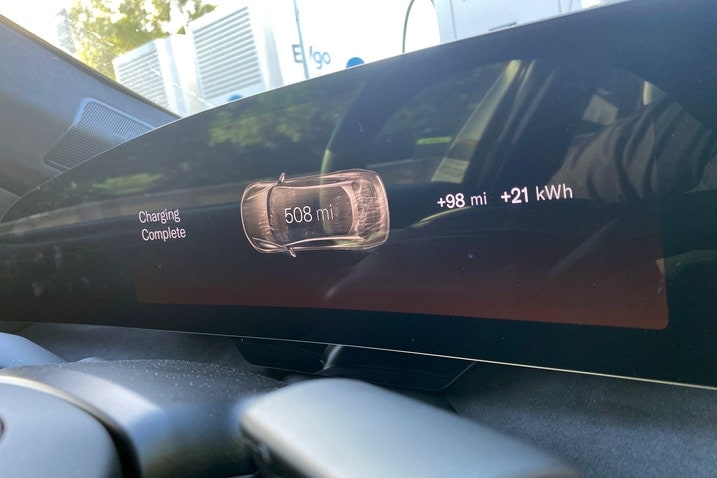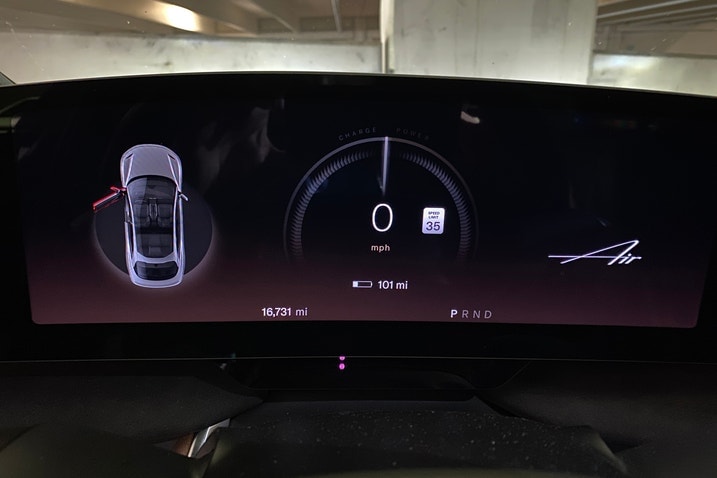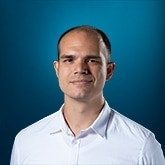- I needed to drive from LA to Vegas to attend a press event, and the round trip covered a distance of 510 miles.
- Our long-term Lucid Air has an EPA-estimated range of 516 miles.
- Could I make it from LA to Vegas and back on one charge?
Can the Lucid Air Go From Los Angeles to Las Vegas and Back on One Charge?
Testing the Air's consumption at highway speeds, unscientifically
Last month, I attended the Karma Kaveya reveal in Las Vegas. In deciding which one of our long-term test vehicles I would drive to the event, I was struck by a flash of stupidity/brilliance. My house to the Virgin Hotel was 255 miles one-way, or 510 miles round-trip. Our 2022 Lucid Air electric sedan has an EPA-estimated range of 516 miles. Could our silver chariot make it from Los Angeles to Las Vegas on one battery charge? There was only one way to find out.
Planning the route
After patting myself on the back for coming up with such an inspired test, I almost put the kibosh on the entire plan once I read our team's results driving the Lucid Air on our Edmunds EV Range Test. The Air Grand Touring only managed to return 465 miles on a full charge — good enough to make it No. 2 on our range leaderboard, but well below what I'd need to travel to Vegas and back. I shifted gears and began researching DC fast-charging stations along my route.
While there are many Tesla Superchargers along I-15, DC fast chargers with the CCS combo plug that the Lucid uses are in shorter supply. And since the Air can support charging speeds up to 300 kW, I'd want to specifically target stations delivering at least that much power if I had to make an emergency stop on my way home. I had no doubt that I could at least make it to Las Vegas with quite a bit of range in the tank, so I didn't even begin by researching stations in town. My worst-case scenario was having to fill up in Baker, 90 miles from my hotel. There were 11 Electrify America stations just down the road from the world's largest thermometer, each outputting a healthy 350 kW. We've had troubles with EA chargers in the past, but I felt it was unlikely that so many chargers would fail at one spot, and there were a handful of slower EVgo chargers nearby in case things really went pear-shaped.
But what if my efficiency was actually through the roof? The next viable option would be Barstow, 153 miles from Vegas and 63 miles from Baker. The best choice there would be a bank of EA chargers, with six rated at 350 kW. A little over 30 miles south is Victorville with four 350-kW EVgo chargers, and just beyond is Hesperia with nine 350-kW EA chargers. And If I could make it down the Cajon Pass (gaining considerable battery charge along the way thanks to regenerative braking), I could hit one of seven EA chargers in Ontario pumping out 350 kW. The plan was set, with multiple contingencies on the way back depending on how far I could strecth the Lucid. Time to pack and head off. After setting up every method of vehicle entry first, of course — no need to for this to become The Lucid Air Adventure: Part 2.
Before I begin
The parameters of the test were as follows: I would charge the vehicle to 100% the morning of the trip, right before leaving home. I also wouldn't be hypermiling while on the road. The speed limit on much of I-15 through the desert is 70 mph, and I would be traveling ... about that. I wouldn't goose the throttle and take advantage of the Lucid's prodigious power, but I planned to cruise at a decent rate. Previous trips to Vegas at similar speeds have returned fuel economy averages that are right about those vehicles' respective EPA highway estimates — I've achieved 25.9 mpg against a 24 mpg estimate for our Jaguar F-Type SVR, and 33.3 mpg against a 36 mpg estimate in our Toyota Sienna (loaded with four people and luggage).
Am I Ready for an EV?
- EV ownership works best if you can charge at home (240V outlet) This typically means a 240V home installation, or other places your car is parked for several hours each day. Don't expect a regular household outlet (120V) to suffice.
- Adding a home charging system is estimated to cost $1,616 in This is an estimate for your area. Using your address and the answers you provide, Treehouse can provide a more accurate price.
- Edmunds is partnering with Treehouse, an independent provider of home EV installation services. Learn more Edmunds customers receive a 10% installation discount and 4% smart charger discount. Discount excludes permit, hosted inspection, and load management devices. Valid for 30 days.
My departure day started with completely recharging the Lucid; it showed an estimated 508 miles of range when I unplugged. I input my destination as the Virgin Hotel in Las Vegas, and the navigation system calculated I would arrive with 135 miles of range left. Thus, the computer calculated that the Air would use a Lucid-estimated 373 miles of range (hereafter referred to as "Lucid Miles") to travel an actual distance of 255 miles, leaving me with a theoretical maximum of 390 miles combining the actual distance traveled plus the estimated Lucid Miles remaining. My dreams of a round trip on a single charge were dashed almost immediately, changing this test from "Will the Lucid make it there and back?" to "Which station will I charge at during my return?"
After unplugging, I drove home to grab my gear, then conducted a quick round trip to Starbucks to thank my wife for watching our infant daughter for the next 2.5 days. The entire jaunt amounted to aboout 5 miles of wasted range. Now with 503 Lucid Miles on the meter, I began my trip in earnest.
Driving our EV with questionable reliability into the Mojave
The first two hours were uneventful, and the Air proved to be a comfortable companion on the open road. A few miles north of the state Route 60/Interstate 15 interchange lies the Cajon Pass, which connects Rancho Cucamonga as its base to Victorville via a roughly 2,500-foot climb. It can be taxing in parts for underpowered gasoline cars, but my electric steed blazed up without issue. Looking back, I probably should have turned down the adaptive cruise control speed on this section of the drive in particular. Doing so might have given me enough wiggle room on the return. But I get ahead of myself.
I pulled into Barstow station with 109 miles on the trip odometer and 356 Lucid Miles remaining — a total of 465 theoretical miles. Even at my elevated highway speed and the sprint up the Cajon Pass, I was actually doing better than the Air's computer estimated when I initially typed in my destination. Could this actually work?
It was after another long climb to the top of Halloran Summit, just north of Baker, that reality set in again. The trip computer noted 192.1 miles since my charge, with 200 Lucid Miles still on deck. I was about halfway through my battery but I still had a while to go before I was even at the midpoint of my trip. There was no way I'd make it back to LA on a charge, and my most optimistic solutions for the return trip were fading from contention.
I pulled off I-15 with the Strip in sight, heading into Henderson for lunch before arriving at the hotel. Traveling a few miles at sub-highway speeds and with braking events recharging the battery surely helped extend the range a tad, I thought. Nevertheless, I arrived at the Virgin Hotel with 107 Lucid Miles in the "tank" and about 264 miles on the trip.
It's at this point that I questioned the ability of the car to even make it to Baker, 90 actual miles away from the hotel. There's a climb out of the Las Vegas Valley, and another to the Halloran Summit, before the downhill to Baker. I might have been lucky to make it had I left then and there, but a couple nights in the cool fall air could have vampired enough charge to shut me out of Baker for good. I began to research DC fast chargers in Las Vegas proper, a possibility that I hadn't even considered beforehand.
A premature charge
To my surprise, there weren't many non-Tesla DC fast chargers on or around the Strip. Electrify America operates the highest number of station clusters, but there are only two located on the I-15 corrdior: a set of six stations south of Harry Reid International Airport and a set of six located at the back entrance of the Forum Shops attached to Caesars Palace. There's also a cluster of four EA charge points just east of Virgin. I picked the Caesars stations as my target; if I needed to charge, I could easily duck into the hotel for a bite to eat while the car recharged.
The morning after I arrived, I jumped into the Air to assess the overnight loss. Lucid Miles left: 101.
I assumed I would lose at least another 6 Lucid Miles by the next morning — the day I was set to depart. If I wanted to be heroic and try to make it to Baker, my estimate gave me a theoretical 95 Lucid Miles to drive 90 actual miles to Baker, plus I'd have to account for increased consumption in the two uphill sections and climate losses in the interim. If I hadn't gone to Starbucks, or had taken it a little easier on the Cajon Pass or decreased my cruising speed a few mph on the highway, I might have been able to trudge into Baker on electronic fumes and hoped that one of the EA chargers was free.
It was probably for the best, then, that the window of success was so narrow. If I had another 10 additional Lucid Miles, I might have been tempted to go for it. But the odds were so stacked against me (so typically Las Vegas) that I couldn't bring myself to risk it. I started the Air, drove through Formula 1 construction to the Forum Shops, and parked at a 350-kW EA station, which was confusingly located near an employee-only entrance. After verifying that none of the other charging EVs had an easily identifiable parking pass — and thus satisfying my bulletproof logic that the police surely couldn't ticket all of us civilians, right? — I plugged in and entered the casino for a light breakfast at Bacchanal Buffet. I returned about an hour and a half later to a fully recharged sedan showing 507 Lucid Miles left.
The return home was a much different story
I parked the Air at my hotel for one last night, then began my return journey the next morning. Not needing to really worry about extracurricular driving now that my range "test" was over, I traveled to a different hotel/casino for breakfast and swung by a nearby Pinkbox Doughnuts to grab treats for the ladies at home. By the time I jumped off the freeway just a few miles from my house, I had logged 266.1 miles on the trip computer, with 231 Lucid Miles left in the battery. That gives us a theoretical maximum of 497 miles on the return trip, compared to a theoretical maximum of 371 miles on the journey to Vegas (the 264 miles actually traveled plus 107 Lucid Miles at the moment I parked at Virgin). The 120-mile swing is massive when you consider the only appreciable difference between the two trips was uphill versus downhill travel.
The takeaway
Looking back at the trip, there were some things I could have done to make the highway range test more successful. The first, of course, is changing the route itself. If I had purely wanted to conduct a range test at highway speeds, I would have chosen a route with little elevation change in a more rural area to reduce the traffic variable. I could have also traveled at a lower rate of speed to reduce the amount of power required from the motors and to lessen the impact of wind resistance. But this was about a specific road trip from LA to Vegas — a common enough jaunt if you live in either metro area — and I wanted to run the Air at speeds similar to those I've made on many previous trips.
So what about the variables specific to this journey? I could have skipped the Starbucks trip at the onset, but I needed as many Dad Points as I could hang onto for leaving the little one with Mom. If I hadn't stayed in Vegas two nights and instead just turned around and went back home (thus nullifying vampire drain while the car was static in the parking garage), that would have been good for a few miles, too.
A solo traveler starting east of downtown LA with a completely topped-off Lucid Air and maybe targeting a maximum of 70 mph would likely make it to Vegas and back to Baker on one charge. The town of Barstow roughly 60 miles farther down the road would be a tougher achievement. You'd have to go in a temperate time of year where you can keep use of the climate system to a minimum, lower your max speed, and possibly draft behind larger vehicles like semitrucks. You'd also have to bet on the smaller number of Barstow EA stations working and not occupied.
And for good measure, a small wish list consisting of changes that that would have made the trip easier:
- More non-Tesla fast-charging stations in Las Vegas. There's a surprising lack of these in the biggest city in the state of Nevada, and finding an open one required a lot of luck. Many hotels have Level 2 chargers that would have recharged the Lucid over the course of my stay, but the number at each is small relative to the number of rooms, and the Virgin Hotel had none at the time I visited.
- The EPA should have more than just a single consumption and range estimate. Gas-powered vehicles have fuel economy estimates based on the EPA's city, highway and combined tests, and while not always replicable in real life, they give buyers an expectation of consumption. Electric vehicles have one number for consumption and range, but it would be helpful to know what to expect when planning for a road trip.
Edmunds says
So the Los Angeles to Las Vegas road trip didn't go exactly as planned, but we gathered valuable information about the Lucid Air's consumption and economy at highway speeds.









 by
by